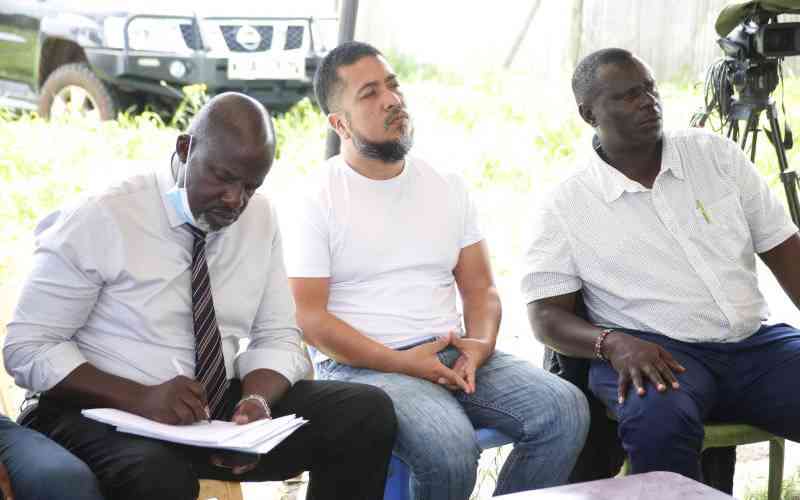By HUDSON GUMBIHI
[email protected]
City police dogs have for decades been a subject of much curiosity and speculation. You have probably heard the one about the dogs having ranks, just like their two-legged counterparts. A human police constable, so goes the tale, would therefore be required to salute a canine that holds the rank of inspector whenever the two cross paths.
Then there are stories about the lavish meals prepared for them, their ability to sniff out criminals or narcotics from kilometres away, their rigorous training regime and the elaborate honours they are accorded upon death (21-gun salute and all).
To sieve fact from fiction, The Nairobian visited the Lang’ata-based Police Dog Unit, which trains and takes care of the canines that help officers to deter and investigate crime.
The unit has about 5,000 dogs deployed in almost all the counties. They are usually at key installations like airports, water reservoirs, Parliament and the Kenyatta International Convention Centre. Some are attached to VIPs, especially the President.
“We cover the entire country, including entry points where dogs are deployed with handlers,” says the unit’s commandant, Gideon Ngumi.
The canine law enforcers patrol streets, sniff out explosives and narcotics and chase or help arrest fleeing crime suspects (the crime-busters are known to use their powerful jaws to detain criminals).
Ranks
So do senior police dogs bark orders at their juniors, including humans? Or to put it more pointedly, do police dogs have ranks?
“No, no, they don’t have ranks or titles, we identify them by names,” says Ngumi, amused by our question.
Some of the dogs currently at the unit are identified by common names like Banda, Figo, Buffy, Shanghai, Brux, and Sussy among others. That means there is no chance of a dog going by the title ‘Inspector Mbwa Kali’ punishing his human counterpart, ‘Constable Mtu Mpole’, for insubordination.
Breeds
According to the commandant, the most popular police dog breeds are the German Shepherd and the Belgian Malinois.
“We are unable to acquire the Belgian Malinois because it is expensive. However, they are the best and can serve for about 15 years,” says the commandant as he takes us around kennels holding hybrid dogs.
Apart from the German Shepherd, other breeds at the unit include Rottweiler, English Springer and Labrador. There is usually cross breeding at the Dog Unit.
Stay informed. Subscribe to our newsletter
“We do a lot of breeding, take care of them by making sure they are fed on a balanced diet and ensure the kennels are clean,” says Ngumi, a veterinarian, who joined the police service in 1991 and has risen through the ranks.
The German Shepherds are usually used for attacking, tracking and crowd control while the Labradors are used for sniffing drugs and explosive materials. The dogs do not come cheap. For example, a single German Shepherd can costs about Sh500,000 to import.
The dogs are at their most active between the ages of eight months and eight years.
Food and care
The canines are fed pre-cooked food once a day. However, puppies eat three times a day. The food is careful prepared and preserved to avoid poisoning. The diet must contain at least 25 per cent protein and 10 per cent fat. The average dog weight is about 60kg
The dogs are also vaccinated against rabies and are regularly dewormed.
Training
The dogs are trained in patrol and tracking skills, narcotics and explosives detection.
Training starts when the dogs are about five months old. They are then deployed after three months if they meet performance standards.
“Training is meant to condition them to certain situations like the smell of different drugs,” says Ngumi.
The unit has a training centre with three faculties: Explosives headed by Superintendent Nicholas Ouma, Narcotics led by Chief Inspector Samuel Boit and Protection under Inspector Omar Bakari.
There are about 500 dog handlers at the unit. They teach dogs to obey commands and perform specific tasks. These can range from simple obedience training to more advanced instructions and complex tactics.
The trainers usually wear protective gear like bite sleeves and bite suits, some weighing up to 25kg.
“They must pass the agile training, which is mandatory,” says Ouma. Agility basically involves exposing the canines to endurance and physical tests.
Retirement
What happens when old dogs can quite literally no longer be taught new tricks? Well, did you know that when a police dog becomes ‘inactive’ it is killed as a sign of honourable exit?
The dogs are retired if they become injured to an extent where they will not recover completely or before they get to a state of being unable to perform.
The canines are euthanised (taken through ‘mercy killing’). Ngumi explains this is carried out because the inactive canines can neither fit in the police unit or in society.
“It is an honourable exit because if we gave them out to the public, most people don’t know how to deal with these dogs. They will suffer yet we don’t want them to be mistreated,” says Ngumi.
However, another theory is that it could be a fertile ground for corruption if the public is allowed to acquire such dogs.
“Somebody can just cunningly certify that an otherwise fit dog is old and unfit in order to make money,” said an officer.
The dogs are normally put down by intravenous injection containing a high dose of pentobarbital or sodium thiopental. The few that escape death are either donated to the Kenya Society for the Protection and Care of Animals or the University of Nairobi’s College of Agriculture and Veterinary Sciences.
If these dogs are killed in the line of duty they get the same honours as their human partners.
 The Standard Group Plc is a
multi-media organization with investments in media platforms spanning newspaper
print operations, television, radio broadcasting, digital and online services. The
Standard Group is recognized as a leading multi-media house in Kenya with a key
influence in matters of national and international interest.
The Standard Group Plc is a
multi-media organization with investments in media platforms spanning newspaper
print operations, television, radio broadcasting, digital and online services. The
Standard Group is recognized as a leading multi-media house in Kenya with a key
influence in matters of national and international interest.
 The Standard Group Plc is a
multi-media organization with investments in media platforms spanning newspaper
print operations, television, radio broadcasting, digital and online services. The
Standard Group is recognized as a leading multi-media house in Kenya with a key
influence in matters of national and international interest.
The Standard Group Plc is a
multi-media organization with investments in media platforms spanning newspaper
print operations, television, radio broadcasting, digital and online services. The
Standard Group is recognized as a leading multi-media house in Kenya with a key
influence in matters of national and international interest.








